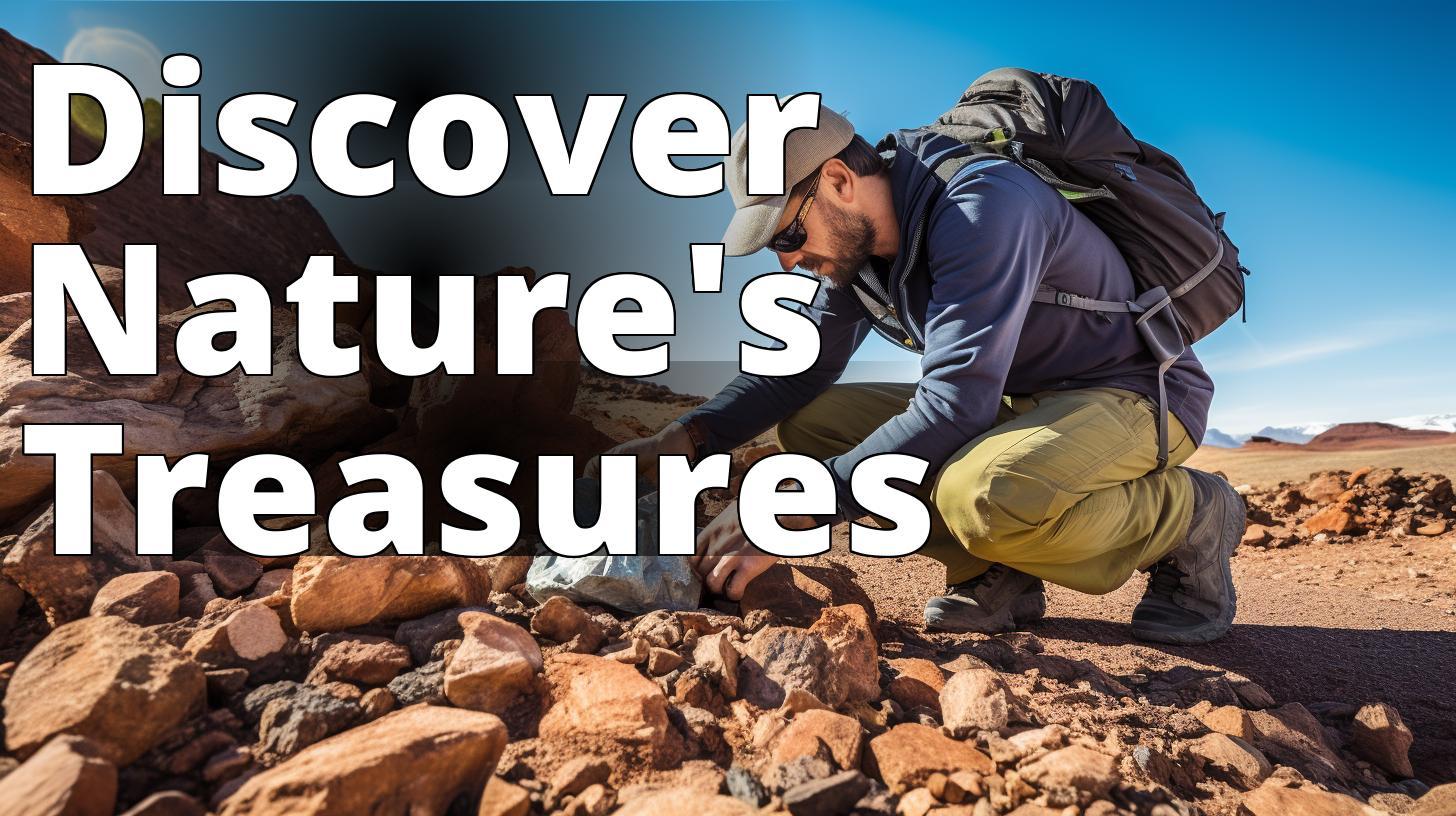Are you looking for the best Canadian rock and mineral collecting sites? Look no further! As a rock and mineral enthusiast myself, I have explored various locations across the country and have compiled a list of the top places to collect rocks and minerals in Canada.

Popular Rock and Mineral Collecting Sites in Canada
Canada is a geological wonderland, with a diverse range of rocks and minerals that can be found across the country. Here are some of the most popular locations for rock and mineral collecting in Canada:

Bancroft, Ontario
Bancroft is known as the mineral capital of Canada, with over 200 mineral species found in the area. The Bancroft and District Chamber of Commerce offers a Mineral Collecting Guide that includes information on the local geology, mineral species, and locations for collecting. Popular sites include the Egan Chute, the Bear Lake Diggings, and the York River Skarns.
Bay of Fundy, Nova Scotia
The Bay of Fundy is famous for its dramatic tides, but it’s also a great location for rockhounding. The area is rich in agate, amethyst, and jasper, and there are several beaches where you can find these treasures. Popular spots include Advocate Harbour, Parrsboro, and Five Islands Provincial Park.

Thunder Bay, Ontario
Thunder Bay is another great location for rock and mineral collecting, with a variety of minerals found throughout the area. Some of the most sought-after minerals include amethyst, fluorite, and pyrite. The Amethyst Mine Panorama offers guided tours of their mine and allows visitors to keep what they find.
Canadian Rock and Mineral Collecting Sites
- Overview of the best Canadian locations for rock and mineral collecting
- Information on the types of rocks and minerals present in each location
- Importance of understanding laws and regulations, and minimizing environmental impact.

Geological Formation and Composition of Rocks and Minerals Found in Canada
| Rock/Mineral | Location |
|---|---|
| Amethyst | Thunder Bay, Ontario |
| Agate | Bay of Fundy, Nova Scotia |
| Gold | Canadian Shield |
| Silver | Canadian Shield |
| Copper | Canadian Shield |
| Nickel | Canadian Shield |
| Jasper | Bay of Fundy, Nova Scotia |
| Fluorite | Thunder Bay, Ontario |
| Pyrite | Thunder Bay, Ontario |
Understanding the geology of a location is essential to successful rock and mineral collecting. Canada’s geology is incredibly diverse, with a range of rock types and mineral deposits found throughout the country.
One of the most significant geological events in Canada’s history was the formation of the Canadian Shield, a massive area of exposed Precambrian rock that covers much of the country. The Shield is home to a variety of minerals, including gold, silver, copper, and nickel.
The other major geological event that shaped Canada’s landscape was the last ice age, which ended about 12,000 years ago. The glaciers that covered much of the country carved out valleys, lakes, and rivers, leaving behind a diverse range of rocks and minerals.
Tips for Successful Rock and Mineral Collecting in Canada
Successful rock and mineral collecting requires the right equipment, safety precautions, and knowledge of how to identify rocks and minerals in the field. Here are some tips to help you make the most of your rockhounding experience in Canada:
Equipment
Essential equipment for rock and mineral collecting includes a rock hammer, chisels, safety glasses, gloves, and a backpack to carry your tools and specimens. A field guide can be a helpful resource to identify rocks and minerals in the field.
Safety
Safety should always be a top priority when rockhounding. Be sure to wear appropriate protective gear, bring plenty of water and snacks, and let someone know where you’ll be collecting. Always be aware of your surroundings and never climb on unstable rocks or cliffs.
Identification
Properly identifying rocks and minerals is crucial to your success as a rockhound. A field guide can be a helpful resource, but it’s also important to learn how to use other identification tools, such as a streak plate, a magnifying glass, and a UV light.

Environmental Impact
Rock and mineral collecting can have a significant impact on the environment if not done responsibly. It’s important to follow the principles of Leave No Trace and minimize your impact while collecting. This includes staying on designated trails, not disturbing wildlife or vegetation, and properly disposing of any waste.
Laws and Regulations Surrounding Rock and Mineral Collecting in Canada
Before you begin rock and mineral collecting in Canada, it’s essential to understand the laws and regulations surrounding the activity. Each province has its own rules and regulations, and it’s important to respect landowners and the environment.
In Ontario, for example, mineral collecting is permitted in most provincial parks, but it’s important to obtain permission before collecting on private land. In British Columbia, mineral collecting is allowed on Crown land, but a permit may be required for commercial activities.
Local Rockhounding Clubs and Organizations for Enthusiasts
Joining a local rockhounding club or organization can be a great way to connect with other enthusiasts, learn new techniques, and find new locations for collecting. Popular organizations in Canada include the Canadian Rockhounder, the Calgary Rock & Lapidary Club, and the Edmonton Rock & Gem Show Society.
Resources for Rock and Mineral Identification
Accurate identification is crucial to successful rock and mineral collecting. There are many resources available to help you identify rocks and minerals, including field guides, websites, and smartphone apps. Popular resources include the Peterson Field Guide to Rocks and Minerals, the Mindat.org website, and the Mineral Identifier app.
Personal Story: The Thrill of Discovering Rare Gems in Northern Ontario
As a lifelong rock and mineral enthusiast, I’ve traveled all over the US in search of the perfect specimen. However, one of my most memorable experiences was actually in Canada. My friends and I took a trip up to Northern Ontario, where we had heard rumors of a hidden gemstone deposit that had yet to be fully explored.
We set out early in the morning, driving deep into the wilderness until we reached a remote location that required a bit of bushwhacking to access. As we made our way through the thick forest, I couldn’t help but feel a sense of excitement and anticipation building inside me. After all, this was uncharted territory who knew what we might find?
When we finally reached the site, we were blown away by what we saw. The ground was littered with sparkling gems of all shapes and sizes, ranging from deep blue sapphires to bright red rubies. We spent hours exploring the deposit, carefully selecting the best specimens to add to our collections.
As we hiked back to our car, exhausted but exhilarated, I couldn’t help but reflect on the thrill of discovering something truly special. That’s what makes rock and mineral collecting so addictive the possibility of uncovering something rare, beautiful, and entirely unique. Whether you’re exploring a well-known site or venturing into uncharted territory, there’s always the chance that you’ll stumble upon a hidden gem (quite literally!).
Conclusion
Rock and mineral collecting is an exciting and rewarding hobby that allows enthusiasts to explore Canada’s rich geological history. By following the tips and resources outlined in this article, you can make the most of your rockhounding experience and join a community of like-minded enthusiasts. Remember to respect the environment and obtain permission before collecting on private land. Happy hunting!
Questions
Who can visit Canadian rock and mineral collecting sites?
Anyone interested in lapidary and rockhounding can visit.
What can I find at Canadian rock and mineral collecting sites?
You can find a variety of minerals, fossils, and gems.
How can I prepare for a rockhounding trip in Canada?
Research the location, pack appropriate gear, and know the rules.
Who owns the minerals and rocks collected at these sites?
The minerals and rocks belong to the landowner or government.
What if I don’t have experience with rockhounding?
Join a local club or take a guided tour to learn from experts.
How do I know if I’m allowed to collect at a specific site?
Check with the landowner or government agency for permission and rules.

